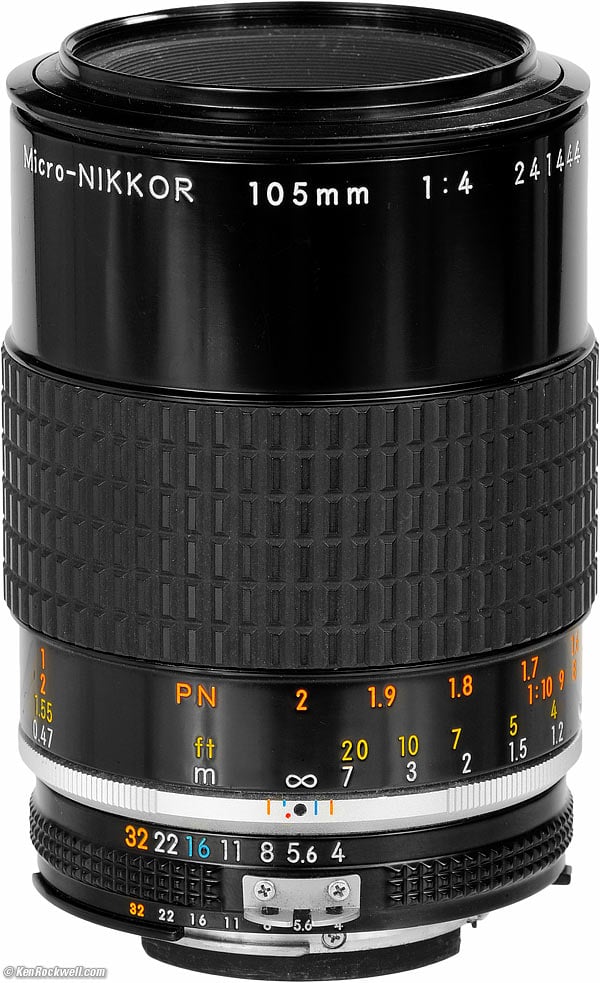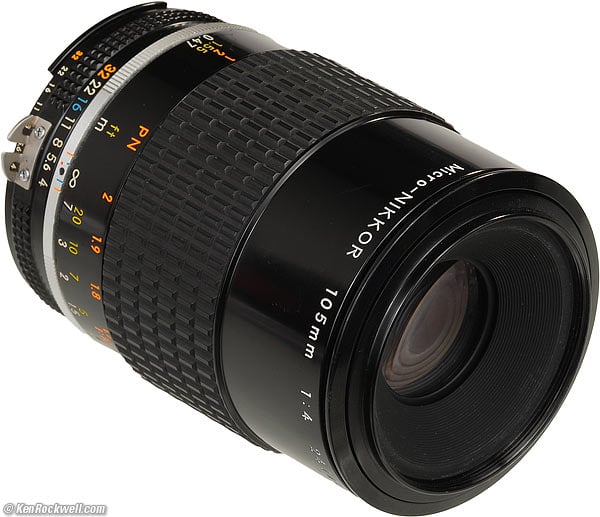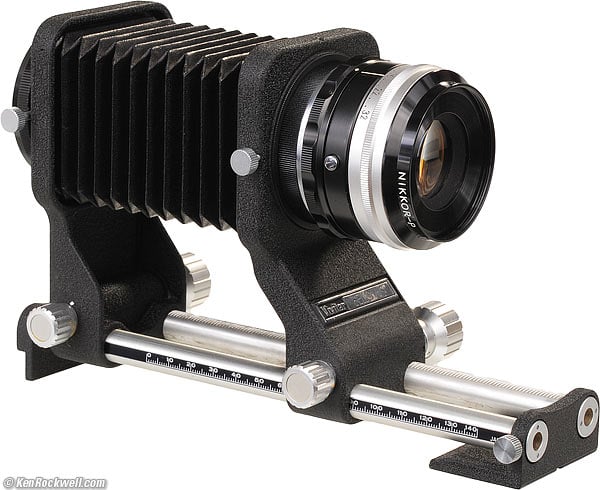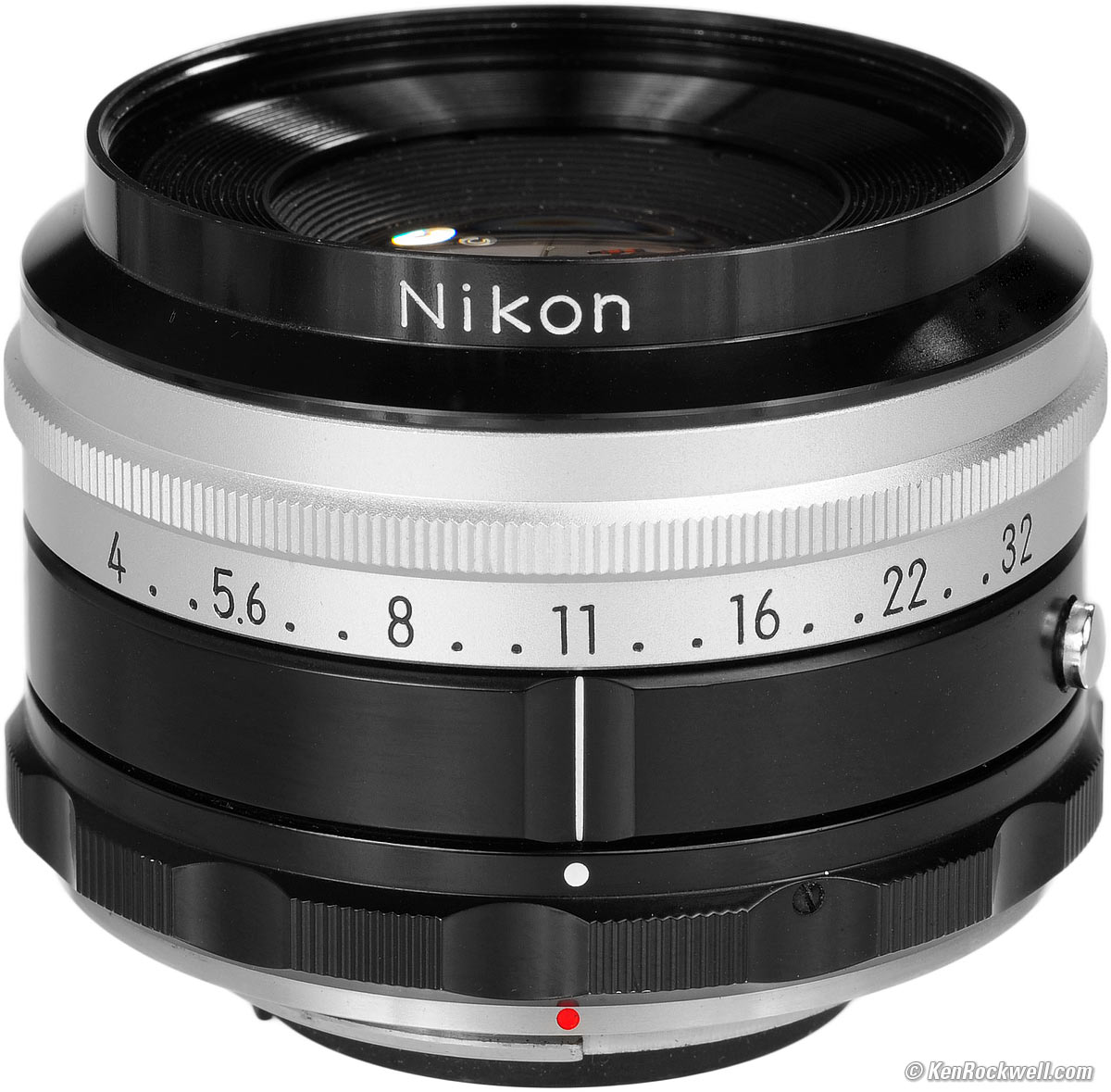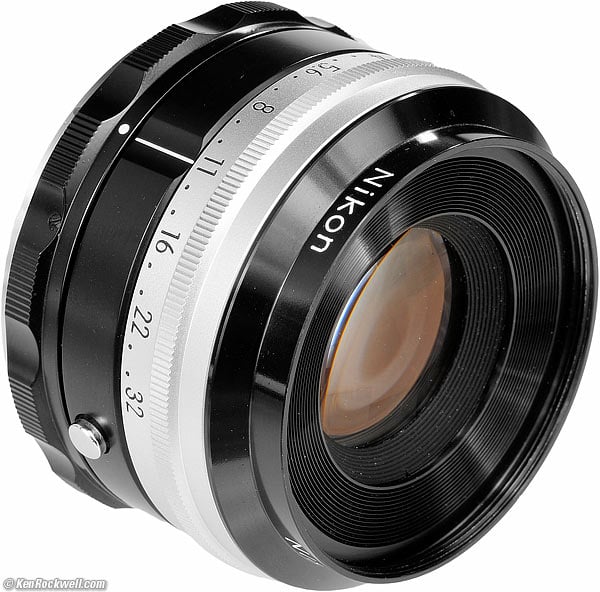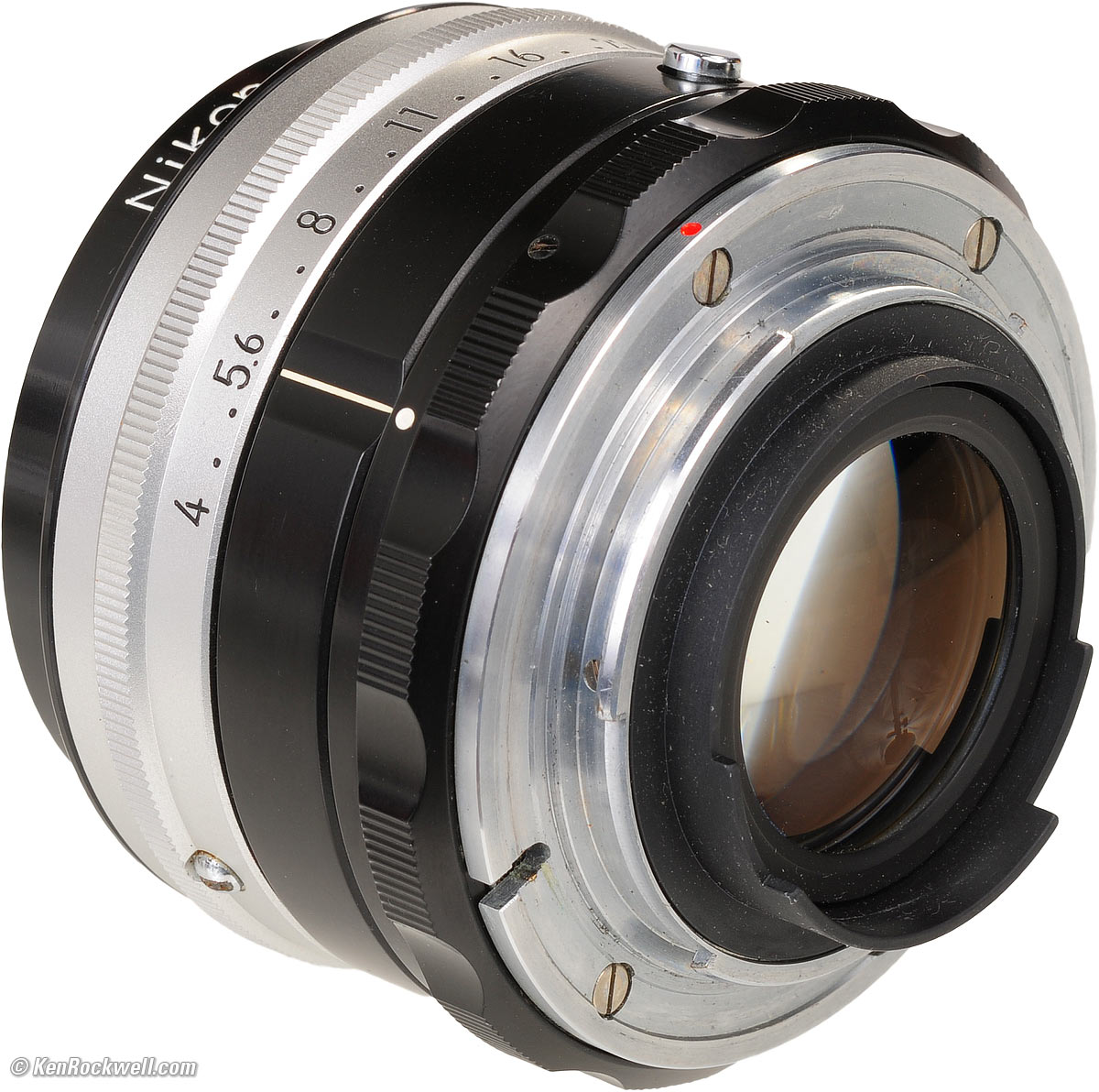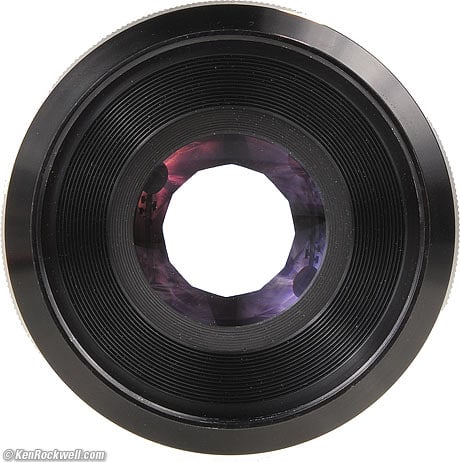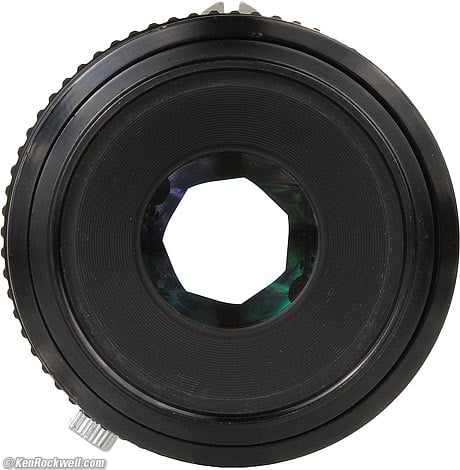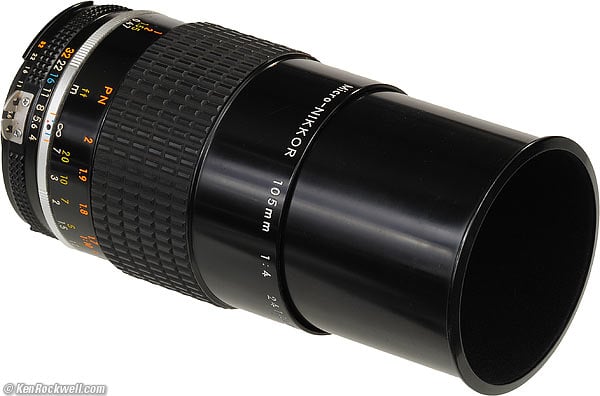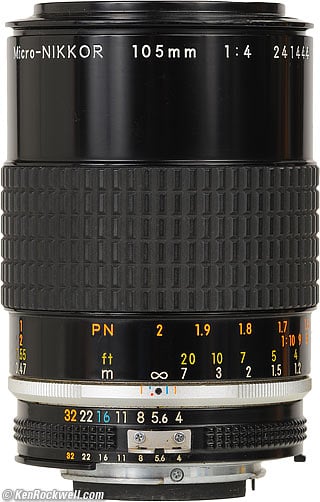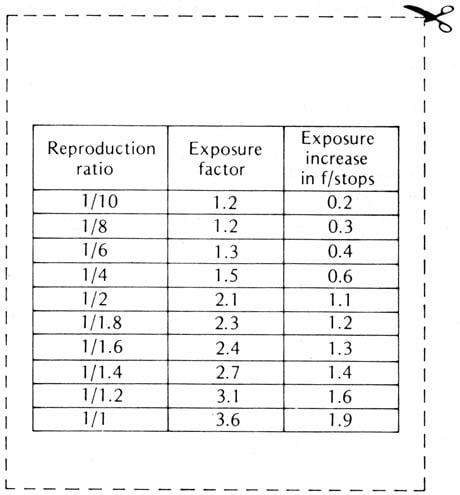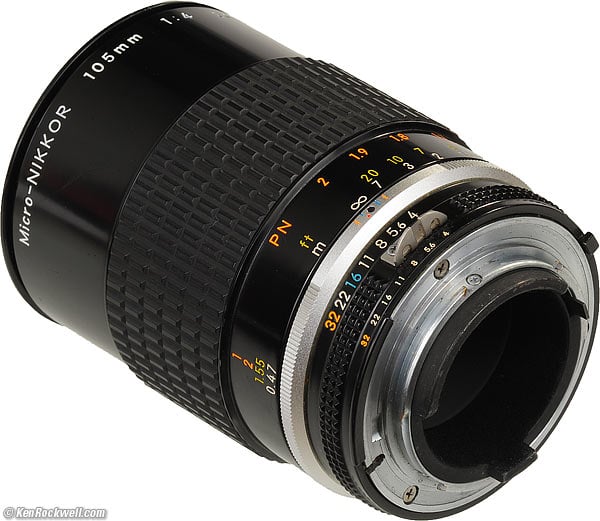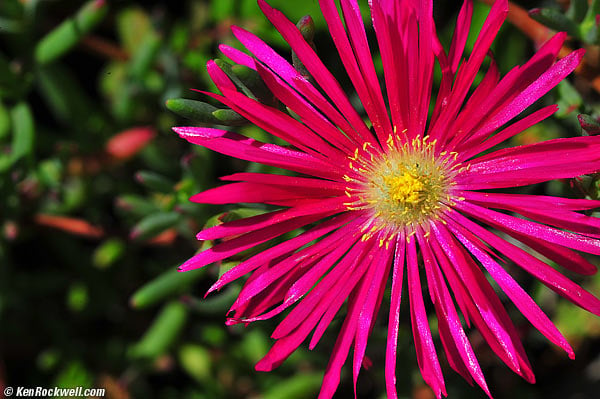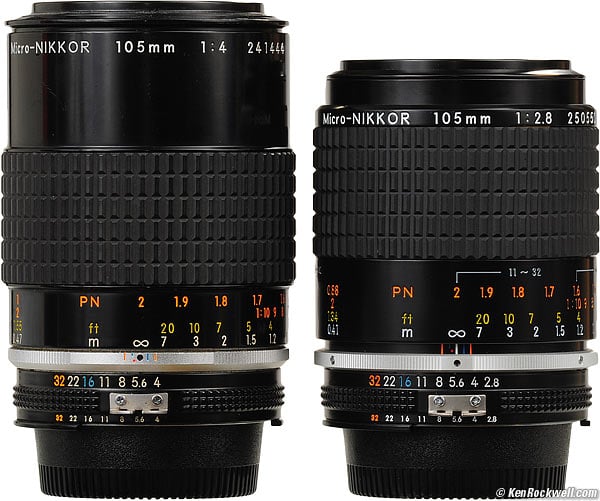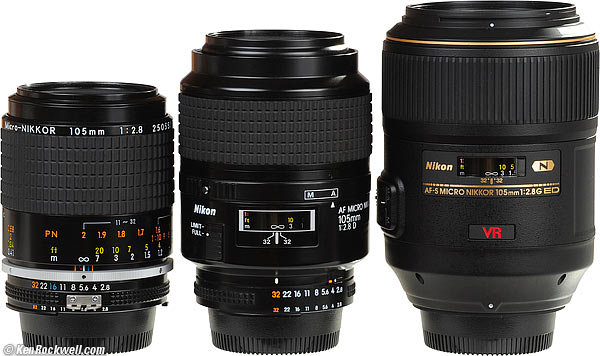Home Donate New Search Gallery Reviews How-To Books Links Workshops About Contact
Nikon 105mm f/4
Micro-NIKKOR (Macro, 1970-1983)
© 2013 KenRockwell.com. All rights reserved.
How to Shoot Macro Best Macro Lenses Compared
Intro Specifications Performance Compared Recommendations
Nikon 105mm f/4 AI-s (FX, DX and 35mm coverage, 52mm filters, 17.6 oz./500g, 1.55'/0.47m 1:2 close-focus, about $75 used). I got this one from this direct link to them at eBay (see How to Win at eBay).
My biggest source of support for this free website is when you use those or any of these links when you get anything, regardless of the country in which you live — but I receive nothing for my efforts if you buy elsewhere. I'm not NPR; I get no government hand-outs and run no pledge drives to support my research, so please always use any of these links for the best prices and service whenever you get anything. Thanks for helping me help you! Ken.
July 2022 Nikon Reviews Nikon Lenses All Reviews
Why fixed lenses take better pictures.
Ideal Uses
General-purpose manual-focus tele and macro for FX and film.
Focus, exposure and viewing are perfect with all FX DSLRs.
Not for
I'd suggest the newer, faster f/2.8 lenses for manual-focus cameras (film), because this f/4 aperture is much dimmer than f/2.8 when trying to focus through older ground-glass or split-image rangefinders, especially at macro ranges. (It's great with today's DSLRs.)
As a manual-focus lens, I wouldn't use it for sports, kids or action since it's too hard to track focus by hand.
| Optics: | |
| Ergonomics: | |
| Usefulness: | |
| Availability: | |
| Overall: |
Introduction top
Intro Specifications Performance Compared Recommendations
The Nikon Micro-NIKKOR 105mm f/4 has excellent optics and mechanics. It is at least 90% as good as today's newest 105mm lenses wide-open, and at least as good stopped down. Unlike the newest lenses, it is manual-focus only, which is ideal for macro work.
"Micro" is Nikon's word for Macro. I will use these words interchangeably.
This f/4 lens was replaced in 1983 by the current (but uncommon) 105mm f/2.8 AI-s, which is a stop faster. When one focuses more closely, images from macro lenses get darker. This f/4 lens is great for general photography, however it gets inconveniently dark on manual-focus cameras at very close distances. The finder screens of manual-focus cameras are optimized for faster lenses, thus the f/2.8 model was created to ease close-up focus.
On AF and digital cameras, their finder screens are optimized for lenses like this 105mm f/4, so with modern cameras, this old lens works just great! In fact, with the electronic focus assist on FX cameras, this lens works much better today than it ever did on film.
This f/4 lens also has a deep built-in lens hood, while all the newer f/2.8 lenses have none.
This review concerns itself primarily with the conventional 105mm f/4 Micro lenses made from 1975-1983.
The manual-focus Nikon 105mm f/4 AI and AI-s work great with most Nikon cameras, film and digital.
They work flawlessly with every manual focus Nikon ever made, from the F of 1959 through the FM3a and today's FM-10.
On the D4, D800, D800E, D600, D3X, D3s, D3, D7100, D7000, D700, D300, D200, D2 and F6, use the "Non-CPU Lens Data" menu option to set 105mm and f/4 to get full matrix metering, EXIF data and finder read-out of set aperture. It works great in aperture-preferred as well as manual modes on these cameras.
These work perfectly on every professional film camera (F, F2, F3, F4, F5, F6), and add Matrix metering on the FA, F4 and F6.
The meters of cheaper digital (D90, D5000 and below) and cheaper film cameras (N80 and below) will not couple (or work at all) with this lens, so you'll be on your own guessing exposure using the rear LCD or an external meter, or get a tiny Gossen Digisix meter and hot shoe adapter to meter manually.
The non-AI lens (1975-1977) works great on the Nikon F, and ought to be updated to AI for use today.
The bellows lens needs a bellows, and then it works with stop-down metering on most cameras, except the ones that can't meter with AI lenses.
See Nikon Lens Compatibility for details on your camera. Read down the "AI, AI-s" column for this lens.
Nikon 105mm f/4 AI-s. enlarge.
Versions
This review concerns itself primarily with the conventional 105mm f/4 Micro lenses made from 1975-1983, however from 1970-1974, Nikon made a short-mount version intended for use on bellows:
Same optics, different mount: Nikon 105mm f/4 NIKKOR-P short-mount on a 1960s Vivitar bellows (1970-1974, 52mm filters, 8.6 oz./242g). enlarge.
This short-mount version has exactly the same optics other than being only single-coated, and when used on bellows, can be focused from infinity to larger-than-life. It has a manual pre-set diaphragm:
Nikon NIKKOR-P 105mm f/4 for use on bellows. bigger.
To select an aperture, press both unlock buttons on the middle black ring, and rotate the middle black ring to the desired aperture. To focus, turn the rearmost ring to the left to open the diaphragm to f/4. To meter or shoot, flick the rear ring to the right; it will stop exactly at the set and locked aperture. Flick the rear ring back and forth as you focus and shoot. Now do you appreciate the automatic diaphragms we've had in most conventional lenses since the 1960s?
Short-mount NIKKOR-P 105mm f/4, for use on bellows. enlarge.
Rear, Nikon NIKKOR-P 105mm f/4 for use on bellows. enlarge.
The advantage is that you get continuous focus from infinity to larger than life, however, the necessity of carrying a big bellows made it less attractive for general photography.
This version was single-coated, which is more than adequate for this simple design, and had a wonderful 12-bladed preset diaphragm.
Nikon made about 7,000 of these short-mount lenses.
Unless stated otherwise, this review refers to the conventional-focusing versions.
1975-1977
The first focusing (conventional barrel) version is for the Nikon F. It won't mount on most modern cameras unless it is first updated to AI, which isn't a big deal, but why bother when you can buy the newer versions below for the same price?
Nikon made about 13,000 of these.
1977-1981
The AI version is wonderful, since it works on almost all Nikon cameras.
Nikon made about 44,000 of these.
1981-1983
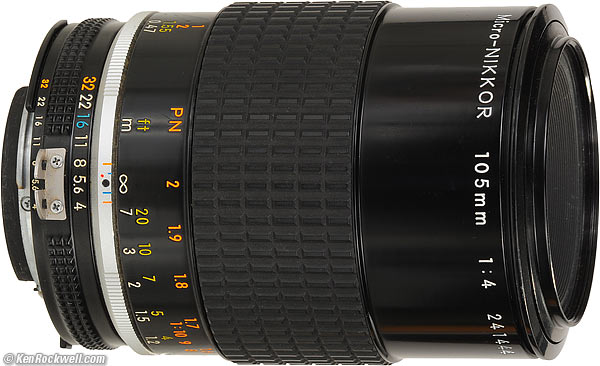
Nikon 105mm f/4 AI-s.
This AI-s version does the same thing as the AI version, the difference being that the focus ring stays put so that the depth-of-field scale is engraved on the silver ring as dots, and not as lines etched on the black barrel.
The AI-s version is also identified by having both f/32 markings painted orange on the aperture ring.
Nikon made about 25,000 of these.
See also Nikon 105mm Macro History for newer versions.
All in all, considering that this f/4 lens is more than fast enough for use on today's FX cameras, and that autofocus and VR aren't used for serious macro work with strobes, this old f/4 lens is just as good as Nikon's newest!
Specifications with commentary top
Intro Specifications Performance Compared Recommendations
Name
Nikon calls this the Nikon Micro-NIKKOR 105mm f/4.
The bellows-mount lens was called the Nikon NIKKOR-P, the P meaning five (penta) elements.
Optics top
Diagram, Nikon 105mm f/4 AI-s. enlarge.
5 elements in 3 groups.
Except for the single-coated bellows lens, it's multicoated.
Diaphragm top
Nikon 105mm f/4, preset bellows version, at f/5.6. enlarge.
Nikon 105mm f/4 AI-s at f/5.6. (Note focus drag screw.) enlarge.
The bellows version has a magnificent 12-blade preset manual diaphragm.
All the other conventional versions have 7 straight blades.
They all stop down to f/32. The bellows version has click-locks at every third of a stop, and the regular versions have the usual full-stop clicks.
Aperture Ring top
Yes, metal.
Full-stop clicks.
The bellows version has a smooth manual actuator and a setting ring with locking third-stop intervals. Bella!
Close Focus top
1.55 feet.
0.47 meters.
Bellows version: n/a.
Working Distance top
11" (280mm), measured at 1:2, hood retracted, AI-s version.
Maximum Reproduction Ratio top
1:2.
With the PN-11 extension tube, 1:1 life-size. (the non-AI version also uses the non-AI PN-1 tube).
With bellows, unlimited.
PN-11 Auto Extension Tube top
52.5mm flange-to-flange length.
2.8" (70.5mm) diameter by 2.7" (67mm) overall length.
Rated 8.6 oz. (245g).
Nikon part number 2647.
Takes BF-1A body cap and LF-1 rear cap.
Optional #61 pouch.
Focus Lock top
Yes.
A small chrome set screw on the focus scale at about the 2 feet (0.6m) position allows one to increase focus drag to prevent accidental knocking in laboratory setups.
It doesn't actually "lock" the focus; it merely makes it stick pretty hard.
Hard Infinity Focus Stop? top
Yes.
This is great for astronomy; just turn to the stop and you have fixed laboratory-perfect focus all night.
Focus Scale top
Yes, detailed.
Depth-of-Field Scale top
Yes, but limited.
Infra-Red Focus Index top
Yes: red dot near depth-of-field scale.
Filter Thread top
52mm, metal.
Does not rotate.
Tripod Collar top
None on lens.
Rotating tripod collar on optional PN extension ring with 90º click stops and locking screw.
Size top
AI-s version (1981-1983)
Nikon specifies 96mm extension from flange (104mm overall) by 68.5mm diameter.
Non-AI and AI versions (1975-1977 and 1977-1981)
Nikon specifies 96mm extension from flange (104mm overall) by 74.5mm diameter.
Bellows Version (1970-1974)
Nikon specifies 1.7" (43.5mm) extension from flange and 2.5" (64mm) diameter.
Weight top
AI-s (1981-1983): 17.643 oz. (500.15g), measured.
Bellows-mount (P, 1970-1974): 8.550 oz. (242.35g), measured.
Nikon specifies 17.6 oz. (500g) for the focusing versions, and 8.1 oz. (230g) for the bellows version.
Hood top
Nikon 105mm f/4 AI-s. enlarge.
Deep built-in telescoping hood, excellent!
Case top
CL-33A hard case, optional.
CL-35A hard case, optional, for use with attached PN extension tube.
CP-2 plastic bubble, optional.
Pouch No. 55, optional.
Pouch No. 56, optional, for use with attached PN extension tube.
Made in top
Japan.
Teleconverters top
Nikon suggests the TC-301 (2x), and any of the TC-14, TC-14A and TC-14B for 1.4x.
The TC-200 and TC-201 may lead to vignetting.
Price, USA top
Prices for AI and AI-s versions. The bellows version is more of a collectors piece and I have no data on it; figure a few hundred dollars used in 2010.
Price, new* |
Corrected for inflation, 2010 |
|
1977 |
$360 |
$1,300 |
1982 |
$360 |
$815 |
1983 |
$260 |
$570 |
2010 |
— |
$125 (used**) |
2013 |
— |
$175 (used**) |
2022 |
— |
* At full NYC discount. Only Pros knew to buy direct from Adorama back then.
** Over this link to it at eBay, typically, if you know How to Win at eBay. From a dealer, you can pay $300 or more for a really nice one. The two you see here came via eBay.
Performance top
Intro Specifications Performance Compared Recommendations
Overall Focus Bellows and Rings Bokeh Color
Distortion Ergonomics Exposure Compensation Falloff
Filters Flare & Ghosts Hood Color Fringes Mechanics
Sharpness Spherochromatism Sunstars
Overall performance top
The 105mm f/4 AI-s is a superb lens, both optically and mechanically. Which would you prefer: today's half-plastic, $900 made-in-China 105mm f/2.8 VR with its crappy plastic bayonet hood, or this all-metal, superbly focusing built-in-hood 105mm Micro for about $125?
Focus performance top
Manual focus is perfect.
Focus is smooth and perfectly damped with no play.
It offers high precision; it takes about 290º to go from infinity to 1:2.
There is a focus lock screw on the focus ring. It doesn't really "lock" as much as it allows the addition of a little more drag so that focus won't get knocked in laboratory settings.
The D3, D3X, D3s, D700, F4, F5, F6 and most professional AF cameras have three very precise electronic manual focus indicators, with which this lens works perfectly.
Lesser digital cameras, like the D300 and down, usually have just one "OK" focus dot, which is not as precise as two arrows and a dot.
With manual-focus cameras, the split-image rangefinder will almost be blacking out most of the time, and will probably be useless up close, so use the microprism. This is why the f/2.8 105mm lenses were invented: for better focus viewing with manual-focus cameras.
Focus is perfect with today's digital FX cameras.
Bellows, PN Rings and Ultra-Closeups top
This f/4 lens works great with bellows and close-up extension tubes like the PN-11.
Because the 105mm f/4 doesn't use (or need) any floating elements or close-range-correction (CRC), the optics are always optimum for use at any magnification.
Because the fixed optics of this 105/4 are always optimum, you may use any aperture at any distance on any sort of tubes or bellows for great results, even at f/4.
By contrast, all newer f/2.8 lenses use CRC, so their optics are no longer optimized at anything other than the closest-focus setting for use on tubes or with bellows. This is why today's 105mm f/2.8 AI-s has gray warnings on its focus ring to stop down to at least f/11 when on a PN ring at 1:2.
Bokeh performance top
Bokeh is the character of out of focus areas, not simply how far out of focus they are.
Bokeh is fair at long distances, and neutral to good in the macro range.
Here are two snaps of a bush at about 10 meters (30 feet), with the bellows lens focused at about 0.6 meters (two feet). These are full-frame images from a D3.
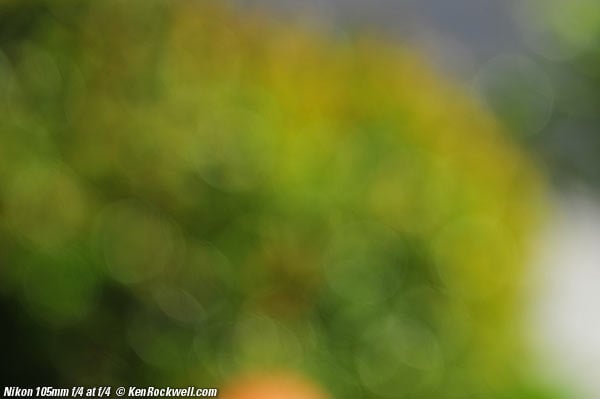
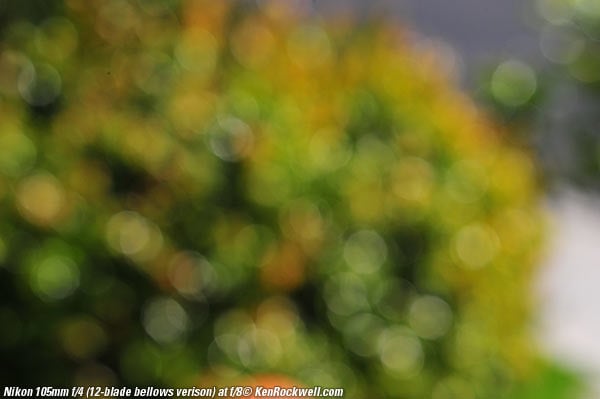
Color Rendition performance top
The color rendition of this multicoated Nikon 105/4 AI-s seems the same as all of my newest multicoated NIKKORs.
Shot with Nikon 105mm f/4 AI-s on a Nikon D3 at f/11. enlarge.
Distortion performance top
The Nikon 105mm f/4 has no visible distortion at any distance.
I wouldn't even bother with these figures into Photoshop CS2's lens distortion filter, because at least through version CS4, Photoshop itself has not enough precision to use values this low!
FX and Film |
||
∞ |
0.0 |
0.0 |
10' (3m) |
+0.1 |
|
3' (1m) |
+0.25 |
|
1:2 |
0.0 |
© 2010 KenRockwell.com. All rights reserved.
Ergonomics performance top
Nikon 105mm f/4 AI-s. enlarge.
The Nikon 105mm f/4's ergonomics are great.
Focus is easy, the hood slides right in and out, and the aperture ring works as on all real NIKKOR lenses.
The only limitation is the slower f/4 aperture, which gets dark on manual-focus cameras. If you're using a camera as old as this lens, the f/2.8 lenses are much easier to focus, especially at macro distances. For all other cameras, especially modern FX digital cameras, this f/4 lens is ideal, and even faster than many inexpensive zooms.
Exposure Compensation performance top
Exposure Factors for external meters, Nikon 105mm f/4 AI.
Macro lenses get darker as focused more closely. To keep it simple, as the lens increases its magnification at close distances, the light gets spread more thinly.
There is never any need to compensate on most cameras, both with regular and flash metering, because they meter the light that actually makes it through the lens (TTL).
If you are unusual and using an external light or flash meter, you will need to open the aperture a bit to compensate for the loss of light at macro distances, in order to get the actual aperture you think you're setting.
Only use this table with external meters. Ignore it otherwise.
If you clip it from your users manual, it is sized to fit in your film-holder reminder slot.
Falloff (darkened corners) performance top
The Nikon 105mm f/4 has no falloff. What microscopic amount it has at infinity at f/4 vanishes at closer focus distances.
I've exaggerated this by shooting a gray field and placing these on a gray background.
Not only is falloff completely invisible in real shooting, it is invisible here, shooting flat fields and placing them on a flat great background.
The falloff is so invisible that many of these images blend right into the gray background!
I've never seen so little falloff! By comparison, today's 105mm VR has much more falloff.
Nikon 105mm f/4 AI-s falloff on FX and film, no correction.
© 2010 KenRockwell.com. All rights reserved.
|
Filters, Use with performance top
There is no problem with vignetting, even with combinations of stacked thick filters.
The 52mm filter size is much more than needed; the front element is much smaller, and the field of view is narrow, so even a stack of filters a few inches deep won't change anything.
Flare and Ghosts performance top
This simple design is completely free from ghosts and annoying flare.
Point it right into the blazing California sun, and if you don't lose your sight first, you'll get this:
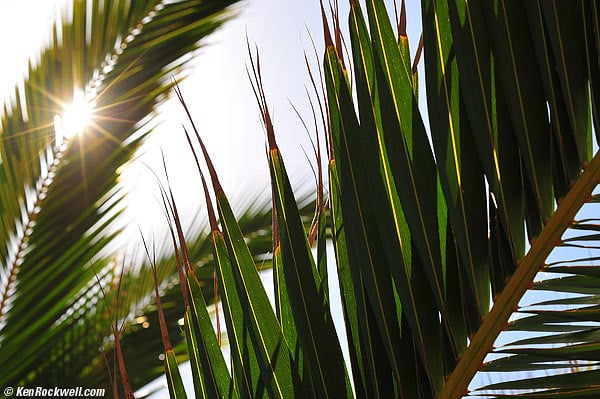
Palm, f/11, +1.7 stops compensation, center-weighted metering, Nikon D3.
You really have to go out of your way to see anything. If I give even more exposure, I can see this:
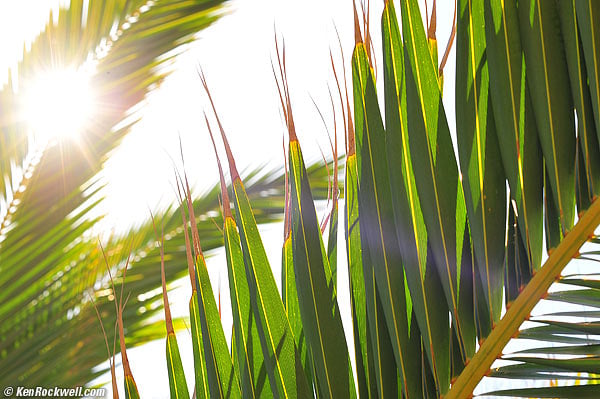
Palm, f/11, +1.7 stops compensation, Matrix metering, Nikon D3.
When I shot each of these, the sun was blinding! You'd never see even this little flare in actual photography.
Hood performance top
Nikon 105mm f/4 AI-s. enlarge.
The built-in retracting hood is excellent; the best hood ever on any Nikon macro lens.
Every other lens needs external hoods, and today, many of these are crappy plastic.
This hood works great, isn't going to break off, and is always with you.
Lateral Color Fringes performance top
There are no lateral color fringes on the D300 or D3, which would correct them if the lens had any.
Used with an adaptor on a Canon 5D Mark II, there aren't any, either, which is a little better than Canon's own $1,000 100mm f/2.8L IS Macro!
Mechanics performance top
Nikon 105mm f/4 AI-s. enlarge.
Like all Nikkor manual focus AI-s lenses, the Nikon NIKKOR 105mm f/4 AI-s is built to the highest mechanical standards of any lens ever made.
Barrel Exterior
Anodized and enameled aluminum.
Filter Threads
Anodized aluminum.
Hood
Anodized aluminum, with extra-thick front collar.
Focus Ring
Metal, rubber covered.
Focus Helicoids
Feels like brass.
Depth-of-Field Scale
Engraved into silver grip ring and filled with different colors of paint.
Internals
All metal.
Aperture Ring
Cast aluminum, anodized and enameled.
Engraved markings filled with different colors of paint coded to the depth-of-field scale.
Mount
Dull-chromed brass.
Markings
Engraved into the metal and filled with paint.
Identity and Serial Number
Engraved into the metal focus ring and filled with paint.
Ass-Gasket (dust seal at mount)
No.
Noises When Shaken
Mild clicking from the diaphragm blades and actuation system.
Made in
Japan.
Sharpness performance top
Shot with Nikon 105mm f/4 AI-s on a Nikon D3 at f/11, hand-held at 1/250. original © file.
Warning 1: Image sharpness depends more on you than your lens.
Warning 2: Lens sharpness doesn't mean much to good photographers.
Warning 3: Lens sharpness especially doesn't matter with macro lenses, since sharpness in macro ranges depends more on our ability to manage planes of focus and depth-of-field than any limitation of the lens' optics. Serious macro shooting is done at f/32, where diffraction makes all lenses equal anyway.
With these caveats, this 105mm f/4 AI-s is as ridiculously sharp as you'd expect from a macro lens.
Here's a hand-held shot from lunch today, wide-open:
Shot with a Nikon 105mm f/4 AI-s on a Nikon D3 at f/4, ISO 3,600, hand-held at 1/60. enlarge or original © file.
As shot on a 24MP Nikon D3X at f/4 and infinity, this f/4 lens is sharper than the Nikon 105mm f/2.8 AI-s (1983-today), but not as sharp as the Nikon 105mm f/2.8 AF (1990-2007).
As shot on a 24MP Nikon D3X at f/8 and infinity, all three are equally excellent.
On a 21MP Canon 5D Mark II with an adaptor, which doesn't correct lateral color fringes as do Nikon cameras, I did a direct comparison between this 105mm f/4 (1970-1983) and Canon's newest 100mm f/2.8 IS L lens (2009-today), Nikon's 105mm f/2.8 AI-s (1983-today) and 105mm f/2.8 AF (1990-2007) lenses.
At f/4 and infinity this old f/4 NIKKOR is about the same as the $1,000 Canon, but at f/8, this old Nikon lens is a little sharper, and has no lateral color fringes! On the 5D Mark II, the manual-focus Nikon 105mm f/2.8 AI-s was best. The 105mm f/2.8 AF was worst, on the 5D Mark II, which has nothing to do with relative performance on Nikon cameras.
As shot on a 24MP full-frame D3X at infinity
At f/4
Sharp in the center, and a little softer on the sides.
At f/5.6
The sides perk right up, and are only slightly less sharp than the ultra sharp center.
At f/8
The center resolution is so good that diffraction softens the center by f/8, and the sides are now as sharp as the center.
At f/11 and smaller
Diffraction limits performance more than the optics themselves.
As shot on a 12MP full-frame D3 or D700 at infinity
(The 12MP cameras aren't as picky about optics as the 24M FX cameras.)
At f/4
Sharp all over, with the sides just a little softer.
At f/5.6
Even sharper, it's now optimum and a little sharper than at f/4, with only the sides trailing just a tiny bit.
At f/8
Perfect all over.
At smaller apertures
Diffraction limits performance more than the optics themselves.
Spherochromatism performance top
The Nikon 105mm f/4 has some slight spherochromatism, meaning that out-of-focus highlights can sometimes take on a little bit of green or magenta color fringes.
If you see it, background highlights might take on slight green fringes, and nearer out-of-focus highlights might take on slight magenta fringes.
Sunstars performance top
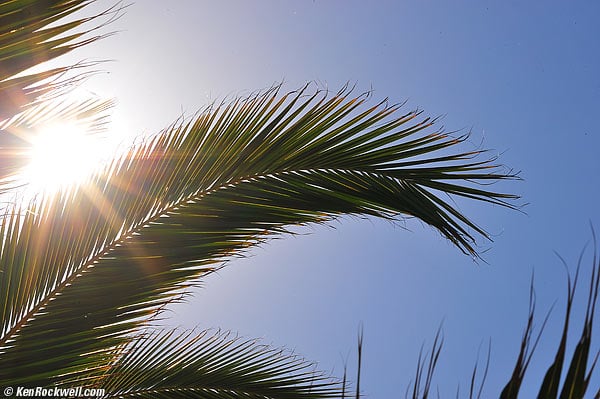
Nikon 105mm f/4 at f/22 on a D3.
With its straight 7-bladed diaphragm, the 105mm f/4 makes great Nikon-standard 14 -pointed sunstars on bright points of light.
Compared top
Intro Specifications Performance Compared Recommendations
See also Best Macro Lenses Compared.
Nikon 105mm f/4 AI-s and f/2.8 AI-s. enlarge.
Nikon 105mm f/2.8 AI-s, f/2.8 AF-D and f/2.8 VR G. enlarge.
See my sharpness comparisons above under Sharpness. All of these are excellent.
Oddly, used with an adaptor on a Canon 5D Mark II, this 105mm f/4 has no lateral color fringes, while Canon's $1,000 100mm f/2.8L IS Macro has just a bit. Wow!
105/4 |
||||||
| Anno | 1970-1983 |
1983-today |
1990-2007 |
2006-today |
2000-2009 |
2009-today |
| Filter | 52mm |
52mm |
52mm |
62mm |
58mm |
67mm |
| Filter | Metal |
Metal |
Metal |
plastic |
plastic |
plastic |
| Length | 96mm |
83.5mm |
104.5mm |
116mm |
118.2mm |
123mm |
| Barrel | Metal |
Metal |
Plastic and metal |
Plastic and metal |
plastic |
plastic |
| Weight, g. | 500g |
510g |
562g |
752g |
584g |
623g |
| Weight, oz. | 17.6 oz. |
18.0 oz. |
19.8 oz. |
26.6 oz. |
20.6 oz. |
22.0 oz. |
| Optics | Ex |
Ex |
Ex |
Ex |
Ex |
Ex |
| Working Distance | 11" |
9.5" |
5.2" |
6" |
6" |
5.2" |
| Working Distance | 280mm |
240mm |
133mm |
154mm |
150mm |
133mm |
| Maximum Repro | 1:2 |
1:2 |
1:1 |
1:1 |
1:1 |
1:1 |
| Manual Focus | Always |
Always |
Must move switch |
Instant override |
Instant override |
Instant override |
| Ergonomics | Ex |
Ex |
OK |
Ex |
Ex |
Ex |
| Price, 7/2010 USA | $125 used |
$150 |
$350 Used |
Recommendations top
Intro Specifications Performance Compared Recommendations
For use on FX cameras like the D3X, D3S, D3 and D700, the built-in hood, extraordinary optics, light weight, exquisite mechanical perfection and low price (typically $125 used) make this 105mm f/4 Micro-NIKKOR a double-duh no-brainer for anyone wanting a high-quality 105mm and/or macro lens. It works splendidly on today's newest digital cameras.
Why instead would anyone want to pay $890 for the mostly plastic, made-in-China Nikon 105/2.8 VR, since you have to carry a separate crappy plastic hood, it has more light falloff, it weighs more, it's bigger and longer, and it's gelded (G) to prevent its use on older cameras? The only reason I can fathom is for people with lots of money to burn, and who intend to use it for general photography, where VR and autofocus are very handy.
For serious 105mm macro use, this 105mm f/4 Micro-NIKKOR is superb. However, for really serious macro use I prefer 200mm lenses because they give me enough room away from my subject and a more pleasing perspective. All the product photos you see on most of my pages, especially this one, are shot with Nikon's 200mm AF-D Micro for exactly these reasons. (I used the 200mm AF-D for the shots of the AI-s 105/4, and just for fun I used this 105/4 AI-s for the shots of the bellows lens.)
I don't suggest Nikon's inexpensive (about $350 used) manual-focus 200mm f/4 AI-s Micro-NIKKOR (1978-2005) for digital macro work because it has a lot of lateral color fringes in the macro range.
The Nikon 105mm f/4 AI-s is a manual-focus only lens, which is an advantage for macro use, since its manual-focus ring is much more pleasant than the AF lens' manual focus rings.
Ironically, this f/4 lens was replaced by today's 105mm f/2.8 AI-s in 1983 to give a brighter viewfinder image for easier focusing with manual-focus cameras, but for manual-focus cameras, I suggest any f/2.8 lens instead. The ironic part is that today's f/2.8 lenses work better on old cameras, while this old f/4 lens works better on today's newest FX cameras than it ever did on the manual focus cameras of its era. Today's cameras are optimized for the slower zoom lenses more popular today, while manual-focus cameras are optimized for faster lenses.
The original bellows-mount version is unusual, and extremely handy for dedicated macro shooting if you need to shoot at many different sizes, from infinity to larger than life, from shot to shot. It saves you from needing and changing close-up rings or other adapters, as every other Nikon Macro lens requires to cover this broad a range of magnifications.
Deployment top
I'd leave either a 52mm Nikon Clear (NC - UV) filter, or a 52mm Hoya Super HMC UV on the lens at all times.
I'd pitch the flat Nikon cap that came with this lens new, and get a new "pinch" type cap in 52mm. I'm not kidding: the new fatter caps are much easier to use in the field.
If I was working in nasty, dirty areas, I'd forget the cap, and use an uncoated 52mm Tiffen UV filter instead. Uncoated filters are much easier to clean, but more prone to ghosting.
Help me help you top
I support my growing family through this website, as crazy as it might seem.
The biggest help is when you use any of these links when you get anything, regardless of the country in which you live. It costs you nothing, and is this site's, and thus my family's, biggest source of support. These places have the best prices and service, which is why I've used them since before this website existed. I recommend them all personally.
If you find this page as helpful as a book you might have had to buy or a workshop you may have had to take, feel free to help me continue helping everyone.
If you've gotten your gear through one of my links or helped otherwise, you're family. It's great people like you who allow me to keep adding to this site full-time. Thanks!
If you haven't helped yet, please do, and consider helping me with a gift of $5.00.
As this page is copyrighted and formally registered, it is unlawful to make copies, especially in the form of printouts for personal use. If you wish to make a printout for personal use, you are granted one-time permission only if you PayPal me $5.00 per printout or part thereof. Thank you!
Thanks for reading!
Mr. & Mrs. Ken Rockwell, Ryan and Katie.
Home Donate New Search Gallery Reviews How-To Books Links Workshops About Contact
